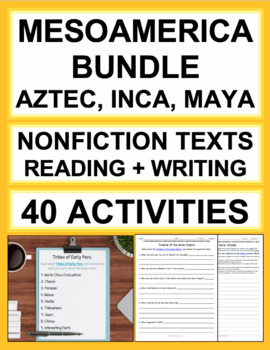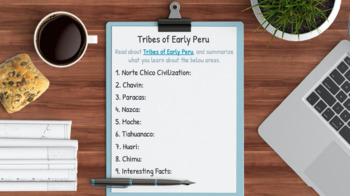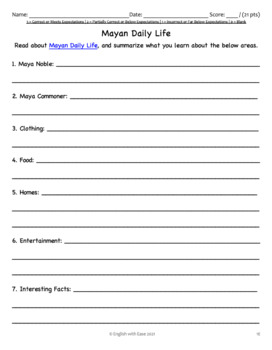Aztec, Maya, Inca, Mesoamerica Unit | Printable & Digital
- Zip
- Google Apps™

What educators are saying
Description
Aztec, Inca, Maya Mesoamerican Ancient Civilization unit (History and ELA-aligned) - 40 reading response and writing activities (Printable & Digital) including student printables, lesson plan, PowerPoint slides, Google Doc, Google Slides, grading rubric, 10 reading response and writing activities to pair with links to 29 nonfiction texts for Social Studies or ELA classroom activities, distance learning, Google Classroom activities. or History Heritage Month (September 15 - October 15).
Aztec, Inca, Maya Mesoamerican Ancient Civilization activities are designed to be appropriate for all ages as you can read the texts aloud to younger students or allow older students to read independently. The editable product also includes elementary and secondary writing prompts (expository, persuasive, narrative).
The reading response and writing activities listed below can be paired with ANY Aztec, Inca, Maya Mesoamerican Ancient Civilization text, and are aligned with social studies and ELA standards. Articles and activities can be completed independently with older students or strong readers or as a whole-class activity with younger students.
Depending on your classroom needs, pick and choose from 10 reading response and writing activities to pair with each of the 29 informational text links.
Product Includes (Printable & Digital):
- Lesson Plan
- Student Printables
- PowerPoint Slides
- Google Doc
- Google Slides
- KWL Chart Bell Ringer & Exit Slip
- Grading Rubric
- Table of Contents
- Hyperlinks to 29 informational texts
- ELA Reading Response Handout
- Common Core ELA Questions
- Informative/Explanatory/Expository Writing Prompt
- Opinion Writing Prompt
- Narrative/Creative Writing Prompt
- 5 Research Writing Prompts (Grade 1 - 7)
10 Aztec Topics - Reading Response Handouts and Nonfiction Text Links:
- Timeline of the Aztec Empire
- Aztec Daily Life
- Aztec Government
- Aztec Gods and Mythology
- Aztec Writing and Technology
- Aztec Society
- Tenochtitlan
- Spanish Conquest
- Aztec Art
- Hernan Cortes
9 Maya Topics - Reading Response Handouts and Nonfiction Text Links:
- Timeline of Maya History
- Mayan Daily Life
- Mayan Government
- Mayan Gods and Mythology
- Mayan Writing, Numbers and Calendar
- Mayan Pyramids and Architecture
- Mayan Sites and Cities
- Mayan Art
- Mayan Hero Twin Myth
10 Inca Topics - Reading Response Handouts and Nonfiction Text Links:
- Timeline of the Inca
- Daily Life of the Inca
- Inca Government
- Inca Mythology and Religion
- Inca Science and Technology
- Inca Society
- Inca Cuzco
- Machu Picchu
- Tribes of Early Peru
- Francisco Pizarro
SEE PREVIEW
You may also like ;)
- Native American History Unit
- Hispanic Heritage Unit
- Asian Pacific Islander Unit
- National Holidays Bundle
- Complete K - 2 Social Studies Curriculum
- Then and Now
- Historical Figures
- U.S. Symbols
- Economics
- Community and Citizenship
This product is aligned with ELA Common Core and Social Studies History Content Standards for the State of California, which are also aligned with the official socialstudies.org standards and the Department of Defense Education Standards:
- California State Standards for Social Studies
- Department of Defense (dodea) Standards for Social Studies
- Socialstudies.org Standards for Social Studies
- 1.5.3. Compare the beliefs, customs, ceremonies, traditions, and social practices of the varied cultures, drawing from folklore.
- 3.2.1. Describe national identities, religious beliefs, customs, and various folklore traditions.
- 3.2.2. Discuss the ways in which physical geography, including climate, influenced how the local Indian nations adapted to their natural environment (e.g., how they obtained food, clothing, tools).
- 3.2.3. Describe the economy and systems of government, particularly those with tribal constitutions, and their relationship to federal and state governments.
- 5.2 Students trace the routes of early explorers and describe the early explorations of the Americas.
- 5.2.2. Explain the aims, obstacles, and accomplishments of the explorers, sponsors, and leaders of key European expeditions and the reasons Europeans chose to explore and colonize the world (e.g., the Spanish Reconquista, the Protestant Reformation, the Counter Reformation).
- 6.2. Trace the development of agricultural techniques that permitted the production of economic surplus and the emergence of cities as centers of culture and power.
- 6.3. Understand the relationship between religion and the social and political order in Mesopotamia and Egypt.
- 7.7. Students compare and contrast the geographic, political, economic, religious, and social structures of the Meso-American and Andean civilizations.
- 7.7.1. Study the locations, landforms, and climates of Mexico, Central America, and South America and their effects on Mayan, Aztec, and Incan economies, trade, and development of urban societies.
- 7.7.2. Study the roles of people in each society, including class structures, family life, war fare, religious beliefs and practices, and slavery.
- 7.7.3. Explain how and where each empire arose and how the Aztec and Incan empires were defeated by the Spanish.
- 7.7.4. Describe the artistic and oral traditions and architecture in the three civilizations.
- 7.7.5. Describe the Meso-American achievements in astronomy and mathematics, including the development of the calendar and the Meso-American knowledge of seasonal changes to the civilizations’ agricultural systems.
English Language Arts Anchor Standards » Reading:
- CCSS.ELA-LITERACY.CCRA.R.1. Read closely to determine what the text says explicitly and to make logical inferences from it; cite specific textual evidence when writing or speaking to support conclusions drawn from the text.
- CCSS.ELA-LITERACY.CCRA.R.2. Determine central ideas or themes of a text and analyze their development; summarize the key supporting details and ideas.
- CCSS.ELA-LITERACY.CCRA.R.3. Analyze how and why individuals, events, or ideas develop and interact over the course of a text.
- CCSS.ELA-LITERACY.CCRA.R.4. Interpret words and phrases as they are used in a text, including determining technical, connotative, and figurative meanings, and analyze how specific word choices shape meaning or tone.
- CCSS.ELA-LITERACY.CCRA.R.5. Analyze the structure of texts, including how specific sentences, paragraphs, and larger portions of the text (e.g., a section, chapter, scene, or stanza) relate to each other and the whole.
- CCSS.ELA-LITERACY.CCRA.R.6. Assess how point of view or purpose shapes the content and style of a text.
- CCSS.ELA-LITERACY.CCRA.R.7. Integrate and evaluate content presented in diverse media and formats, including visually and quantitatively, as well as in words.
- CCSS.ELA-LITERACY.CCRA.R.8. Delineate and evaluate the argument and specific claims in a text, including the validity of the reasoning as well as the relevance and sufficiency of the evidence.
- CCSS.ELA-LITERACY.CCRA.R.9. Analyze how two or more texts address similar themes or topics in order to build knowledge or to compare the approaches the authors take.
Practice reading and writing skills as you learn about Ancient Mesoamerican Aztec, Inca and Maya civilizations.
YOU MAY ALSO LIKE:
- ELA Print and Go Lesson Plans
- ELA Task Cards
- Novel Studies
- Culturally Relevant ELA Lessons
- Emotional Intelligence SEL Curriculum
- Social Justice & Global Citizenship Curriculum
- Poetry Lessons & Units
- Writing & Grammar Units
- Holiday Print and Go Lesson Plans
- Social Studies Lessons & Units
- ELA Rubrics and Assessments
- Differentiation & SpEd Professional Development
Why wait? This huge Aztec, Inca, Maya Mesoamerican Ancient Civilization unit bundle of informational text links, reading response and writing prompts contains everything you need to teach students about Mesoamerica - No prep classroom activities, distance learning or Google Classroom activities for Cesar Chavez Day and Hispanic Heritage Month or ELA or Social Studies activities for any time of the year.





